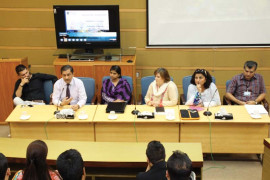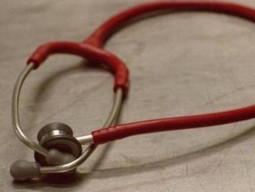
The studies were conducted by various researchers and university professors coordinated by SUN Academia & Research Network Pakistan (SUNAR, Pak) with the support of Australian High Commission.
EU-funded programme for nutrition launched
Nutrition for Pregnant Women
Dr Rameeza Kaleem of Fatima Jinnah Medical University, Lahore, who conducted a four month interventional study on 198 pregnant women in Sir Ganga Ram Hospital, said there was positive effect of nutritional counselling on dietary habits and nutritional status among pregnant women.
Before intervention only three per cent pregnant women were taking appropriate diet, whereas after nutrition counselling and general nutrition education 37 per cent improved their diet and started consuming according to the recommendations of the Food Guide Pyramid. Major improvement was seen in the Fruit and Dairy group intake from 39 to 55 per cent. Similarly, the per centage for Dairy group intake improved from 35 per cent to 62 per cent. Reduction in vitamin D deficiency was noted from 73 per cent to 36 per cent.
Dr Kaleem said nutritional counselling should be made compulsory as part of routine antenatal care provided in healthcare system. Every Gynaecology OPD should have a registered dietician for diet specific and individualised counselling of pregnant women, she added.
Putting phones to use
The study was designed for a low resource community of Khyber-Pakhtunkhwa using a developing Artificial Intelligence (AI) platform to send SMS and Integrated Voice Recordings (IVR) with targeted messages for both the pregnant and lactating mothers, and Infant and Young Children (IYCN) based on their baseline profiles.
Mothers were informed and reminded to take folic acid and iron during pregnancy suggesting when and what to eat their resources. They were also informed about the healthy diet patterns for the infants.
Food consumption and nutrition intake markedly improved among mothers and children and their food choices became very healthy, said Dr Ejaz Ahmad from Health Services Academy, Islamabad, who conducted the study. “Our health system is not approaching mothers, he said adding mothers can make better choices with little guidance and information because local wisdom is there among mothers,” said he.
Nutrition levels: The greener the fields, the healthier the children
Food choices of young
About 150 adolescents between the age of 14 to 19 years of private schools and universities in East Karachi from upper middle income group with 70 per cent of them exposed to excessive screen time were assessed for their food preferences, good habits and other lifestyle behaviours prevalent.
While looking at lifestyle behaviours 68.2% of participants had met the criteria of physical activity that is carrying out at least 60 minutes of physical activity per day.
The study show majority — 84.1 per cent — were consuming three or more meals per day but only 36.6 per cent were consuming vegetables as per WHO recommendations. Dairy products were consumed by 51 per cent whereas 45 per cent consumed whole grain products several times during the week.
A Smartphone app ‘Healthy and Nutrition Daily Guidelines for Youth – HANDY’ was developed that created positive healthy lifestyle behaviors than conventional methods.
Nida Jawed from Dow University of Health Sciences, Karachi who conducted the study recommended to conduct such study with a large sample size and asserted to launch the app through a proper platform like iOS and Android so as to cater a larger audience.
Indigenous meal for broilers
The study suggest using indigenous ingredients including canola, rapeseed, sunflower and guar meals as feedstuff as partial substitute of imported soybean meal for the broiler chicken that are major protein source in Pakistan.
Dr Shafqat Nawaz Qaisrani, Assistant Professor at University of Veterinary and Animal Sciences, Lahore, who conducted the study, said the use of indigenously grown feedstuff will save financial resources and make sure the availability of sustainable and economical animal protein for a common man in Pakistan.
Dr Qaisrani, who is a poultry nutritionist, said there are numerous myths about the poultry feed but it’s made of imported expensive ingredients and a rich source of protein for us.
Local feed for tilapia fish
A similar study suggests that use of indigenous agricultural products can reduce the cost of fish production.
Being cheaper as compared with imported ingredients, local fish meal will increase availability of cheaper and nutritious animal protein to address malnutrition.
Commercial production of tilapia fish started after 2012. Currently, the feed given to tilapia fish is made of imported soybean meal and corn and fish meal that take the food cost to 65-70 per cent.
Dr Fehmeeda Bibi of Bahauddin Zakariya University, Multan, conducted trials in Multan and Sukkur finding out that instead of using imported expensive ingredients indigence plant feedstuff such as wheat, wheat meddling, rice polishing, canola meal, sunflower meal can be used in fish diet.
Speaking at the launch Margaret Adamson, Australian High Commissioner to Pakistan said that “Efforts to end hunger and improve nutrition must be based firmly on good evidence to be effective. That’s why Australia gave 300,000 Australian dollars to improve SUNAR’s ability to produce high-quality research that will shed light on Pakistan’s nutrition challenges, especially for women and children, and provide a strong evidence base for government policy.”
Published in The Express Tribune, March 30th, 2018.


























1714024018-0/ModiLara-(1)1714024018-0-270x192.webp)









COMMENTS
Comments are moderated and generally will be posted if they are on-topic and not abusive.
For more information, please see our Comments FAQ